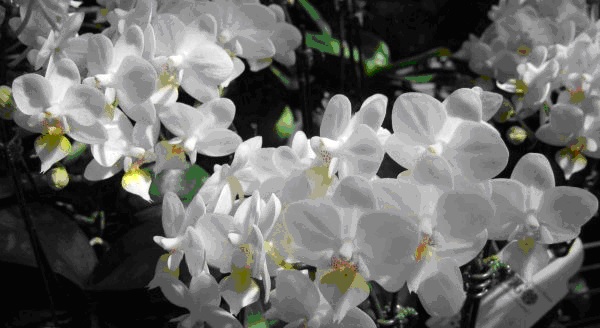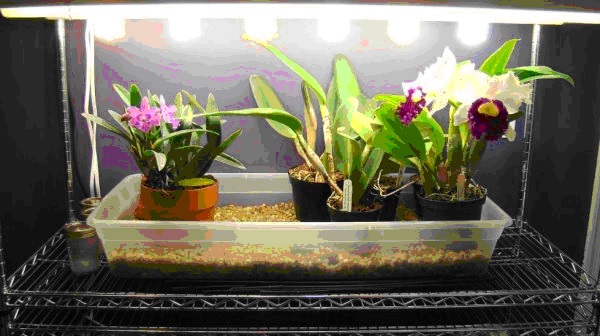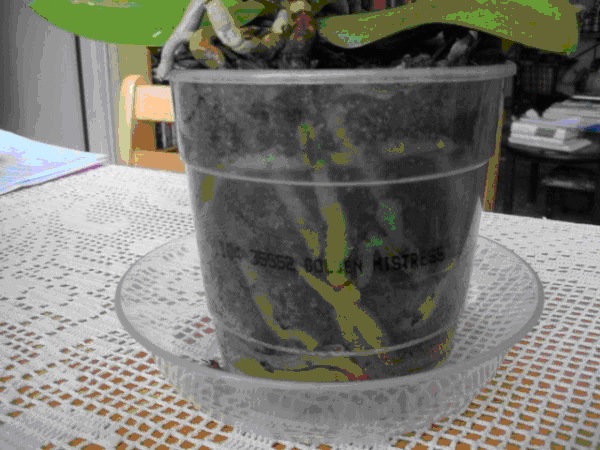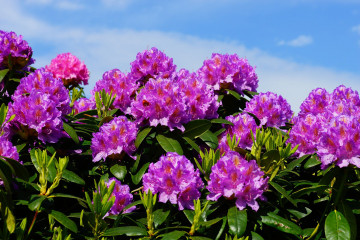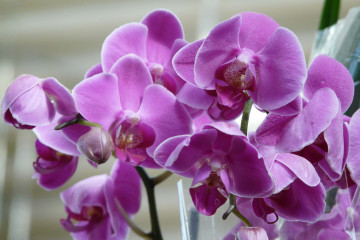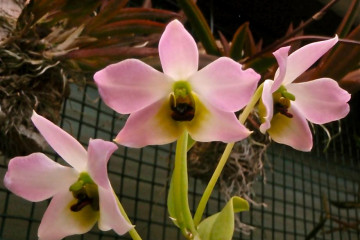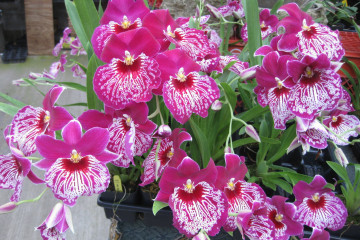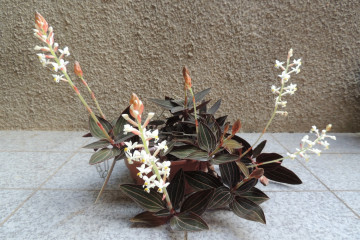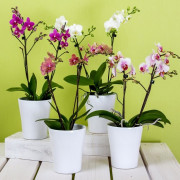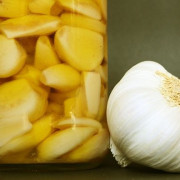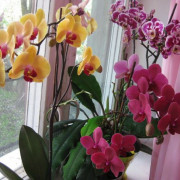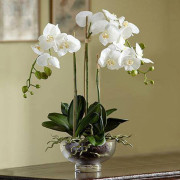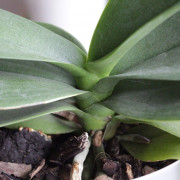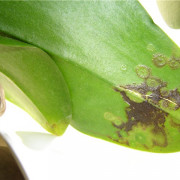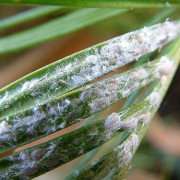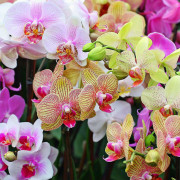How many orchid blooms - care rules
Content:
One of the most difficult periods for plants is flowering. At this time, they need special care and attention. Orchids are no exception. They are considered to be very moody flowers. It is worth figuring out how much the orchid blooms at home.
When and how an orchid blooms
The flowering of different varieties of orchids occurs in different ways. Not only the appearance is different, but also the period (duration) of flowering. Depending on the species, orchids begin to bloom at the age of 1.5-3 years. If the age of the plant at the time of purchase is not reported, it is sufficient to count the number of shoots. 5-8 shoots are enough for age determination. Early flowering is not the most favorable sign. The reason is simple - the plant is still young. It is not worth waiting for the orchid to bloom after transplantation. There is a risk that it will not recover and will die after the first flowering.
When the orchid blooms, the buds near the peduncle appear first. In just one day, the buds can fully open. After a few days, the flowers will begin to grow actively, after which a mature flower will appear. Depending on the type of plant, the color and shape of the flower may vary. Beautiful flowers, pleasant aromas, long flowering - for these reasons, many people like orchids.
Flowering period
With the right conditions and proper plant care, the flower will bloom and be eye-catching for several months. Most orchid species are pleasing to the eye 2-3 times a year. If the orchid is blooming, do not move it from place to place at home.
The emergence of flowers
Pedicels tend to grow in the strangest ways. She can bend into a braid, then begin to grow in an arbitrary direction. When the blooming buds of indoor orchids sprout, the owners should have minimal impact on them. The plant should not be transplanted under any circumstances. Pedicels always start from the point of growth.
It is not difficult for an experienced grower to distinguish a bud from a root. A person without experience cannot always immediately determine which part of the plant is in front of him and how much the orchid blooms. After a short rest, indoor flowers grow for a long time. The beginning of autumn is the most favorable period for new buds. This rule applies primarily to the phalaenopsis species.
Among orchids of the phalaenopsis species, new leaves appear most often in summer or early autumn, and inflorescence stems are formed in late autumn. The long-stemmed buds of a large flower orchid are famous for their massive flowers and can be formed by cutting. During flowering, these plants should be placed in a uniform, moist substrate.
Orchid care at home during flowering
During flowering, you need to organize proper care of the plant.
Watering
Watering is done in two ways. By placing in a container with warm water (preferably boiled) for 10 minutes. Another way is to shower in the form of smooth watering of the plant for 2-3 minutes from a watering can. This method requires you to have a flower pot to easily remove excess moisture. The abundance of water negatively affects growth. Any of these methods are good with two basic rules:
- it is recommended to use boiled water at room temperature;
- it is easier for a plant to survive in the absence of water than in excess.
Fertilizers
It is important to remember the main rule - you need to fertilize the flower only during growth. Use fertilizers no more than once every 2-3 weeks. In this case, the main thing is not to overwork the plant. Use only substrates specifically designed for orchids. Other species can be harmful.
Lighting and temperature
Phalaenopsis is a capricious plant. Satisfying this incredibly beautiful flower is difficult. The flowering period is directly dependent on the light. With sufficient natural light, it grows steadily. It is easy to understand whether a flower has enough light: if there is not enough light, the leaves turn yellow and eventually fall off.
Is it possible to transplant an orchid
Orchids love stability. Any changes in the environment will negatively affect the plant, especially during flowering. Fluctuations in room temperature, improper watering and even moving plants around the apartment can worsen the condition of the flower. Experienced gardeners recommend that you first take care of the location of the orchid after purchase. This will help the plant to bloom on time.
Peduncle support
It is recommended to tie the stalks when they are bent and suspended below the level of the pot. It is important not to damage the roots while working. They are usually intertwined along the walls in orchids. When installing the support, it is necessary to avoid touching the root.
What to do if the orchid does not bloom
If phalaenopsis does not bloom, you need to follow the rules:
- Increase lighting. Phalaenopsis usually blooms twice a year. Adequate lighting is essential. It is best to place the flowerpot on the east side of the room. There should be enough lighting. The duration should be up to twelve hours a day.
- The watering schedule is important. Limit watering to stimulate the pedicels. The plants are allowed to settle for ten days, and then the soil is moistened. The best way to drink water for a plant is by direct watering from a watering can. To do this, a pot of Phalaenopsis orchid is placed in the bathroom and sprinkled with plenty of water on top. Thus, two tasks are solved at once: weeding of the upper and lower roots and the implementation of sanitary procedures. If ten days have passed and the roots are still green, watering is stopped. This situation is caused by condensation on the side of the pot. If so, there is no need to moisten the soil.
- Provide a comfortable temperature. The most important condition is the temperature difference between day and night (within 4-5 degrees). The heat only stimulates the growth of leaf clusters, but not pedicels. During the day, a comfortable temperature is about 20-21 ℃ above zero.
- Correct fertilization. In order for a plant to have the nutrients for flower growth, you need to feed it. Dilute substrates according to package directions.
Bloom extension
Long flowering is possible when the following conditions are met:
- Don't repot the plant.
- It is necessary to ensure the temperature difference between day and night. On average, it should differ by 4-6 degrees. The temperature can be 20-24 ℃ during the day and 14-18 ℃ at night. In winter, ventilation is required. Orchids are sensitive to drafts.
- Air humidity. Orchids love a normal humidity of 60%. If there is not enough moisture, the plant stops blooming. To prevent this, the flower is additionally sprayed with water during dry periods. Or a humidifier is being used.
- Excessive moisture can negatively affect the ability to produce new pedicels in the future. A holy middle is needed here.
- The orchid is planted in a transparent pot. This gives light to the roots and allows monitoring the health of the root system.
- To stimulate the appearance of flower buds, it is recommended to use compounds based on phosphorus and potassium.
Post-flowering care
If properly cared for, an orchid will bloom over and over again. The "rest" period is the most favorable time for transplanting.
Orchid flowering is the most crucial period for a florist. At this time, you need to provide the most comfortable conditions and good care of the plant.
